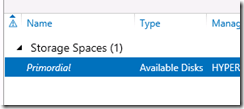New Windows Server 2012 Storage Spaces
It seems that when you begin using Windows Server 2012 Storage Spaces and new disks, you get to play with the underlying fabric of reality.
Well, that’s what it seems like.
Blank disks are called “Primordial” in this console. I find it very funny, but appropriate as well. For, rising out of the primordial hard-drive goo, we have a new underlying storage architecture that can really make a difference in your data center – especially if that data center is a broom closet. In other words, this technology is intended to help administrators manage their storage devices regardless of the underlying architecture – and even make it affordable for small companies to have large amounts of redundant storage.
Storage Spaces can take a large array of disks with no SAN switch or anything other than some drive controllers and ports (more is faster) and create “spaces” which can have parity, mirroring, or maximum space. It can help those of us who have a small “data center” (my actual server closet has a few host machines, but randomly assigned storage) truly be in control of how we use our disk space.
Here is a very good story about Storage Spaces while running an old version of the Windows 8 Server preview:
On top of this, this particular machine is going to host some Hyper-V VMs. The new Storage Space that rose from the primordial disk (I just love writing that!) was used to create a new volume that was formatted with the new file system: ReFS. Also known as the Resilient File System, it is the next generation in file systems and is now included with Windows Server 2012.
I am especially interested in this as it is supposed to be able to deal with the large files that are inherent with virtualization, as well as dealing with “old” hard drives and the ability to recover bad sectors on the fly.
This is an excellent explanation of the new file system:
On top of THIS, I’m going to convert my virtual machine files (VHDs) to the new VHDX format, which will make dealing with unexpected power outages much easier – I needed that a few weeks ago!
Here is some more detail about the new format:
https://technet.microsoft.com/en-us/library/hh831446.aspx
Now, I must get back to playing with (learning) the new stuff.
